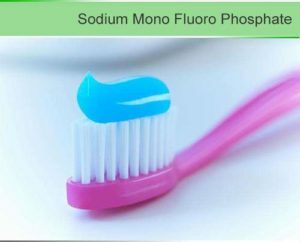 Toothpaste is a pharmaceutical preparation for oral hygiene, intended also as a preventive and therapeutic agent.
Toothpaste is a pharmaceutical preparation for oral hygiene, intended also as a preventive and therapeutic agent.
Thanks to such a preparation, it is possible to effectively clean teeth and provide therapeutic and preventive effects on the oral cavity.
Regardless of the intended use, the chemical composition of the pastes includes the following components:
- Astringent .To the structure of the paste was easy to use and retained its properties for the entire shelf life( agar, pectin, dextran, glycerin, sodium alginate, sodium carboxymethyl cellulose).
- Abrasives .Designed for cleaning( removing plaque, bacteria, food debris) and for bleaching enamel( calcium, sodium, silicon, chalk).
- Surface-active .Used to improve the efficiency of purification with a minimum of damage( sodium lauryl sulfate, betaines).
- Treatment-prophylactic substances .Fluorides, compounds with antimicrobial efficacy, micro- and macroelements, vitamins, minerals, medicinal herbs, propolis, enzymes.
- Fluorides .Sodium fluoride and tin, aminofluoride, monofluorophosphate or calcium glycerophosphate have an anti-carious property.
- Sorbents .They have a soft abrasive effect, an enamel protective effect and eliminate odors.
- Foaming .The amount depends on how much the paste will foam during cleaning.
- Flavors, fragrances, food coloring .Natural essential oils( menthol, limonene) and identical to natural compounds( synthetic hydroxyapatite).
content
- Properties sodium
- value, benefit and harm fluoride monofluorophosphate
- component Use
- Harm fluorine compound
- value fluoride in toothpastes
- Compounds sodium
- sodium and calcium fluoride fluorine
- monofluorophosphate
- aminofluorides( olaflur)
- Fluoride Aluminum
- fluoride
- tin Aschoose paste without fluoride
- Pastes without sodium monofluorophosphate
Properties of sodium monofluorophosphate
Mono-fluorophosphate( Sodium monofluorophosphate) - a compound inorganicOrigin of the sodium salt and ftorfosfornoy acid with Na2PO3F claims.
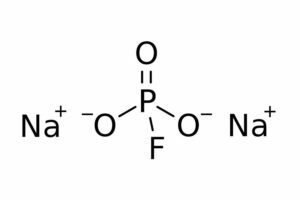 Looks like crystals that do not have a color. Easily soluble in water, forming crystalline hydrates of composition Na2PO3F • 10H2O.The compound is obtained by reaction of sodium trimetaphosphate and sodium fluoride.
Looks like crystals that do not have a color. Easily soluble in water, forming crystalline hydrates of composition Na2PO3F • 10H2O.The compound is obtained by reaction of sodium trimetaphosphate and sodium fluoride.
Mono-fluorophosphate of sodium in toothpaste is an anticarious additive, which helps to strengthen the mineral lattice of tooth tissue. It is also used in some pharmaceuticals to treat osteoporosis.
Depending on purpose and functionality, the component is used as:
- the main active ingredient in dental pastes;
- reagent for water fluoridation;
- intermediate in the synthesis of other fluorine-containing phosphates.
Significance, Benefits and Harms of Fluoride
For the first time fluoride in dental pastes became available as early as 1914 by American pharmacists. After lengthy studies, the main function of the element was confirmed - effective protection against cariousness.
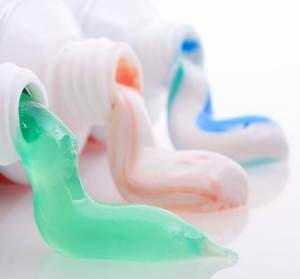
Fluoride based dentifrices reduce the risk of tooth decay up to 45% and increase the resistance of enamel to the negative effects of acids produced by harmful microorganisms.
Fluorine and its compounds are vital elements that are available in water and most foodstuffs.
In case of their lack in the human body begins a carious process, leading to a violation of the integrity of the teeth. To avoid such situations, manufacturers add to the composition of fluoride.
Benefit of the
component The benefits of using fluoridated toothpastes in the oral care are as follows:
- Strengthens the structure of the enamel .The coating of tooth enamel consists of a calcium element in the form of hydroxyapatite, which, upon contact with fluorine, is converted into fluorapatite, creating a stable element against cariogenic bacteria.
- Has a bactericidal property of .A natural antiseptic for pathogenic microflora.
- Do not allow the occurrence of plaque and stone .Prevents the adhesion of bacteria on the surface of the enamel.
- Improves the salivary property of .The glands begin to work better, provoking an influx of saliva with phosphorus and calcium in the volume needed to eliminate caries.
- Required for the metabolism of .Effective effect on the gastrointestinal tract, improves the process of assimilation and well-being.
Harm to fluoride compounds
Adverse effects of fluoride on teeth and the human body are virtually nonexistent.
As a result of the conducted studies, the scientists noticed that 0.5 mg of the substance in a liter of water is not enough for medical and preventive purposes, and 1.5 mg is very high. Therefore, too much fluoride dose is toxic, leading to the appearance of a fluorosis disease.
This is a non-carious disease of the teeth, characterized by the presence of white dots on the enamel, while changing color. The result is yellowing, erosion and tooth decay. It is not unimportant that the increased content of this fluoride compound leads to osteochondrosis, build-up on the bones, change in the shape and color of the teeth themselves.
This substance is difficult to remove from the body. Accumulated, long acting negatively, hitting all the organs.
Uncontrolled entry of a component in different ways leads to such negative consequences as:
- Hormonal imbalance .Fluorine ions, accumulated in the body, negatively affect the production of thyroid hormones( T3 and T4).
- Lowering of testosterone level .Men have problems of a sexual nature, and in women, infertility is possible.
- Decreased intelligence .It has a neurotoxic effect - speech and memory impairment, poor perception of educational material, especially in childhood when studying exact sciences and foreign languages.
For daily use, fluorine-containing oral hygiene products for health and safety are safe with a minimum component content of up to 1500 ppm.
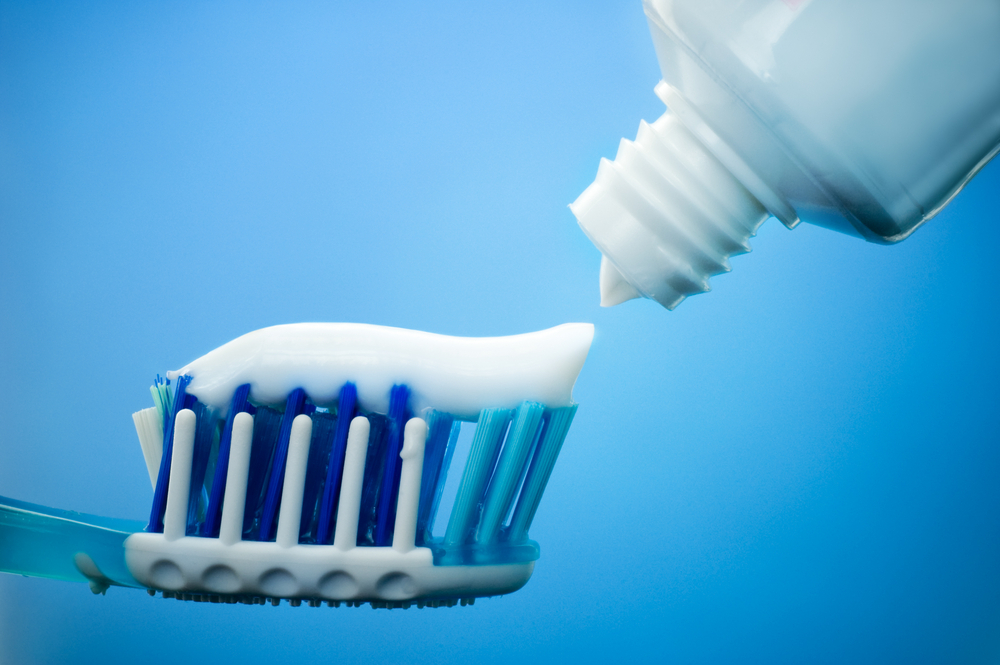
All other varieties of dental pastes are topical for use in such indications as caries or deficiency of sodium monofluorophosphate, alternating them with agents without fluoride.
The importance of fluoride in toothpastes
Toothpaste with fluoride is an important hygienic tool in the everyday life of every person who wants to have a Hollywood smile and healthy teeth. This component prevents the formation of pathogenic flora in the oral cavity, strengthens enamel and is the prevention of caries.
Under its influence, harmful bacteria are less active, less acid and less harmful to enamel. 
Therefore, this paste has its advantages:
- increases the metabolic process of substances;
- acts as an antiseptic;
- does not allow the formation of a hard stone on the surface of the teeth;
- helps to improve the salivary glands.
Fluorine compounds
Fluoride and its compounds are fluorides widely used for more than 100 years and possess good anti-caries effectiveness. They are absorbed into the surface layer of the teeth, not penetrating into the blood, even in case of ingestion. In the production of pastes, the composition includes not only fluorine, but also its compounds.
Sodium monofluorophosphate
Safe, common and inexpensive connection, which does not have a pronounced protective quality. It takes more than three minutes to clean the fluoride film.
Sodium and calcium fluoride
Sodium fluoride is a safe and inexpensive compound. It actively affects the release of ions in order to ensure enamel strength and enrichment with microelements. It has a bactericidal effect on harmful bacteria that cause caries.
Calcium fluoride differs from the previous component in the rate of exposure between saliva and dental tissues.

Aminofluoride( olaflur)
Acts as the most active and expensive compound. It effectively remineralizes and covers the enamel with a protective film, ensuring the longest action.
Aluminum fluoride
Harmful and inapplicable compound due to the ability to accumulate in the body and destructively affect brain cells. But aluminum is needed by man for the regeneration of tissues. It is used as an anti-inflammatory and blocking gum bleeding element. When applied locally, the degree of absorption of this compound is low or zero.
Tin fluoride
Active and unused, despite the effective remineralizing property. Negatively affects the damaged areas of the enamel and seals by changing the color, which is not aesthetically pleasing.
How to choose a paste without fluoride
When choosing a toothpaste without fluoride, you should get advice from a qualified specialist. If, however, you decided to resort to the purchase yourself, then you should pay attention to the chemical composition of the drug:
- in the paste there should be no toxic components;
- avoid colored pastes, due to the presence of colorants.
Paste without sodium monofluorophosphate
A list of dental fluoride-free dentures instead of a toxic component contains calcium compounds( pantothenate, glycerophosphate, lactate and calcium citrate).
A list of such pastes is recommended by many dentists and buyers:
- President Unique .Italian means of soft impact, gently removes plaque, gives shine enamel, protects the gum, teeth become less sensitive. Has antibacterial quality due to the presence of natural ingredients( chamomile, sage, echinacea).Protective function against caries is given by calcium compounds. The presence of the enzyme papain and xylitol allows you to split the plaque and prevent its rapid deposition.
- Parodontax without fluoride .It is active against soft plaque, it is applicable for bleeding gums. In its composition, pharmacy herbs( chamomile, echinacea, ratania, myrrh, sage) and mineral salts.
- Splat biocalcium .A therapeutic and prophylactic agent for daily use, which helps to strengthen and restore the enamel surface up to 35%.The peculiarity of the paste consists in polishing the enamel, neutralizing the pH level of the oral cavity, healing and repairing the mucous membrane.
- R.O.C.S.PRO .Ideal means of Russian production in the care of baby teeth. Almost entirely consists of components of plant origin. The protective function arises from compounds of calcium glycerophosphate and xylitol.
- Weleda Zahngel .Dental gel for everyday hygiene for baby milk teeth on the basis of natural ingredients( extract from algae, calendula, fennel oil, mint).Pasta has an anti-inflammatory effect, cleans plaque. The only drawback of the remedy in the absence of a protective function against dental caries. Therefore, it is necessary to use an additional paste with calcium content.
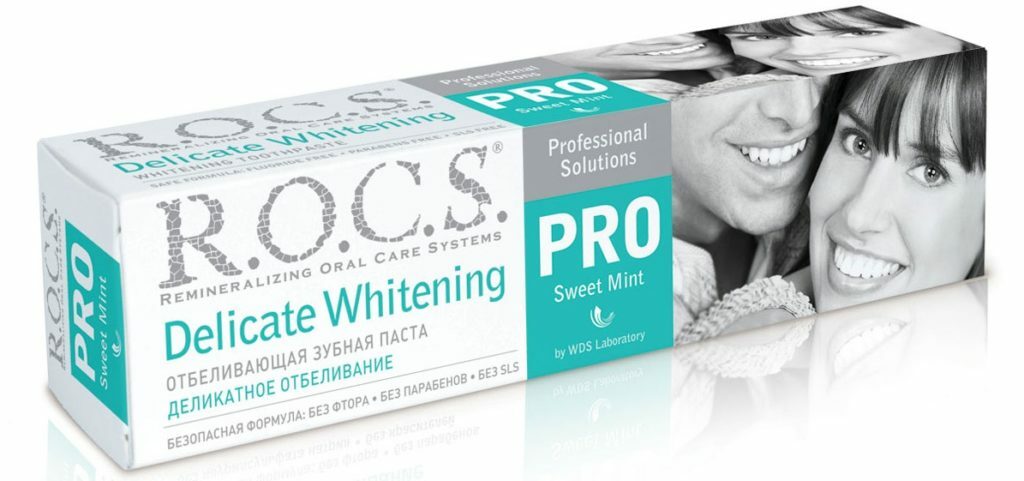
Fluorinated pastes are an important dental product for oral hygiene for the whole family.
Sodium monofluorophosphate is a significant element that reduces the risk of caries, strengthens the surface of the enamel and increases resistance to acids produced by harmful microorganisms.
According to statistical data, consumers who use paste without fluoride are more likely to be exposed to caries and plaque and tartar problems. Such drugs are recommended by most dentists and are offered by many manufacturers.
